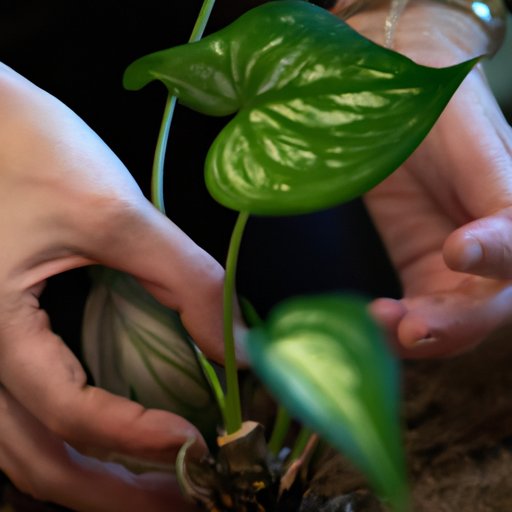
I. Introduction
A money plant is a popular indoor plant known for its ease of care and attractive appearance. Also referred to as Devil’s Ivy, this plant originates from Southeast Asia and is commonly found in tropical climates. By following a few key tips, anyone can care for a money plant and help it to thrive.
In this article, we will cover the essential aspects of caring for a money plant, including proper lighting, watering routines, soil selection, fertilization tips, pruning and trimming methods, prevention of pests and diseases, and propagation techniques. By the end of this article, readers will have a comprehensive understanding of how to take care of a money plant and keep it healthy and beautiful.
II. Understanding the light requirements of a money plant
The first step to caring for a money plant is to understand its lighting needs. Money plants prefer bright, indirect sunlight. Place the plant near a window with a sheer curtain to block direct sunlight. Eastern or western facing windows are ideal for a money plant. Inadequate or inappropriate lighting can lead to stunted growth, yellowing leaves, and eventual death of the plant.
III. Watering routine for a money plant
Watering is a critical aspect of caring for a money plant. Water the plant thoroughly once a week, allowing the soil to dry out slightly between watering sessions. Use room temperature water to avoid shocking the plant’s roots. Overwatering can lead to root rot, while under-watering can cause the leaves to turn yellow and eventually drop off.

IV. Choosing the right soil for a money plant
The right soil is essential for the health and growth of a money plant. Choose a well-draining, loamy soil mix. Adding organic matter to the soil can help retain moisture and provide nutrients for the plant. Repot the plant when necessary, using a pot that is one size larger than the previous pot. This will provide the plant with ample room for growth.
V. Tips for fertilizing a money plant
Proper fertilization can ensure a money plant’s long-term health and vitality. Choose a balanced, water-soluble fertilizer and apply it once a month during the growing season (spring and summer). Do not fertilize during the dormant season (fall and winter). The plant needs three primary nutrients: nitrogen, phosphorus, and potassium. These essential nutrients help in promoting healthy growth, blooming, and development of foliage in money plants.
VI. Pruning and trimming a money plant
Pruning and trimming are necessary to keep a money plant healthy and attractive. Use clean, sharp pruning shears to remove dead or yellowing leaves and stems. Cutting back the plant can also encourage new growth and prevent it from becoming too leggy. However, avoid pruning more than a third of the plant at once.
VII. Preventing pests and diseases in a money plant
Money plants can be susceptible to pests, resulting in stunted growth, yellowed leaves, and eventual death of the plant. Common pests include spider mites, scale insects, and mealybugs. Overwatering can also lead to pathogens taking over, causing root rot. To prevent pest infestations, ensure proper watering techniques, avoid over-fertilization, and remove any dead or decaying plant matter promptly. If an infestation does occur, use an appropriate insecticide or fungicide.
VIII. Propagating a money plant
Propagating a money plant is an excellent way to grow new plants from an existing one. Use cuttings with no less than two leaves to propagate new plants. Dip the cuttings in rooting hormone and plant them in moist soil immediately. Provide the plantlets with bright, indirect light, and keep the soil moist until roots develop. Once the new plants have rooted, gradually increase their exposure to light and water them according to the typical routine.
IX. Conclusion
Caring for a money plant is a rewarding experience that anyone can enjoy, regardless of their gardening abilities. By following these tips, readers can help their money plant grow and thrive for years to come. Remember to maintain a consistent watering routine, choose the right soil, fertilize lawfully, trim the plant, prevent pests and diseases, and propagate when necessary. Implementing these tips can help anyone grow a beautiful and healthy money plant.
It is time to give your money plant a little TLC. Start caring and see how fast and healthy your money plant will grow. Share your experience and share this article with friends and family.




